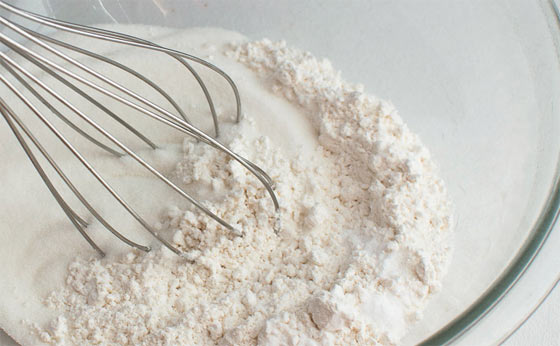Food Storage Shelf Life For PreMix Of Cakes And Breads

If you’ve ever considered (for your food storage) a premix of dry ingredients for breads, cakes, cookies, etc. and storing the combination in individual bags or mason jars (etc.) for storage purposes – here’s my opinion regarding potential long term food storage issues of a premix.
The dry premix ingredients will likely include some combination of flour, sugar, salt, baking powder, baking soda, dry milk, possibly powdered eggs, and yeast (for breads).
The wet ingredients (to be added later), although obviously not part of your premix storage, might include some combination of water, oil, shortening, butter, eggs, milk, and flavoring additives.
To determine the feasibility of a premix, we first need to look at the practical shelf life of the individual dry ingredients.
Shelf life depends on several factors including the method of storage, temperature of storage, and also what the manufacturer considers to be the threshold whereby taste, texture, and other parameters are negatively affected.
SUGAR
No problem for a premix. Commercial white sugar has an indefinite shelf life because it does not support microbial growth. Just store in a moisture-proof environment in a cool, dry place.
I have read mixed reports on the shelf life of brown sugar, with some manufacturers indicating an indefinite shelf life, while others indicate 6 months or a year. I’ve also read that apparently you should not vacuum-seal brown sugar because it can develop bacteria when in oxygen-free storage.
I would err on the side of caution and if you need to get your hands on brown sugar, simply make your own when needed by adding 3 ounces of molasses (by weight) with 1 pound of sugar.
SALT
No problem for a premix. Salt has an indefinite shelf life. It will clump when moist, but that’s about it.
BAKING POWDER
Though baking powder (and baking soda) aren’t subject to spoilage, both may eventually fail to rise to the occasion as leavening agents for baked goods. Baking powder consists of baking soda and one or more salts, plus cornstarch to absorb moisture.
Unopened baking powder remains good indefinitely, but once you open a container of baking powder its potency starts to diminish (from moisture in the air). So long as it is kept sealed up in a dry container, it ‘should’ last for quite a long time (indefinite?). It’s the opening and closing and then reopening and closing that allows more and more moisture to be absorbed into it over time to reduce its effectiveness.
BAKING SODA
When a recipe contains baking powder and baking soda, the baking powder does most of the leavening. The baking soda is added to neutralize the acids in the recipe plus to add tenderness and some leavening.
Baking soda has an indefinite shelf life if stored in a sealed container in a cool dry place.
DRY MILK
No problem for a premix. According to the USDA, powdered milk can be stored indefinitely, if dry.
POWDERED EGGS
Stored in the absence of oxygen and placed in a cool storage environment, dehydrated powdered eggs generally have a storage life of 5 to 10 years. Once dried eggs are opened, they need to be used within one to two years.
YEAST
Yeast expires because it’s ‘alive’, a micro-organism (a fungus) that eventually dies. Yeast has a stamped expiration date, but various conditions (where and how yeast is stored) affect it’s shelf life. The shelf life of yeast will be extended if it is kept in the refrigerator, and even longer in the freezer.
An unopened package of instant yeast typically has a shelf life of up to two years (up to 5 years in the freezer?).
When combining yeast in a premix of other dry ingredients, the effective storage life of the premix (which contains yeast) will likely hinge on the yeast itself.
FLOUR
Milled Flour, the most substantial ingredient, has a somewhat short shelf life (because it’s already milled-ground).
Unopened bags of white flour typically stay fresh for up to a year. As the flour ages, and depending on storage conditions, the flour will eventually develop a bad taste and then go rancid (especially wheat flour). Smell the flour. It will taste like it smells. It may even develop creepy crawlies depending on storage.
Having said that, I’ve consumed processed white flour that was several years old without issue (it was stored well).
Note: Wheat (not having been milled yet) may last decades if stored properly (naturally preserved in it’s shell – the bran).
Shelf Life Of Premix
Depending on what’s in your premix, limiting factors include the flour (~ 2 years), powdered eggs (~ 2 years), and yeast (~ 2 years).
Since flour is used in ALL of the recipes for cakes, breads, or cookies, an approximate 2 year shelf life may be the underlying limit for a premix.
Note regarding vacuum-sealed flour:
“It will also store much longer if vacuum-sealed, BUT, it needs to be vacuum-sealed in a jar or a canister where it remains free-flowing, rather than in a FoodSaver bag where it will get packed tightly. There is moisture in flour, and when it’s packed tight in a FoodSaver bag it can develop a musty smell, so the FoodSaver people suggest vacuum-sealing it in a jar or canister.”
Anyone else tried ready-made premix of dry ingredients?
How have you stored them?
